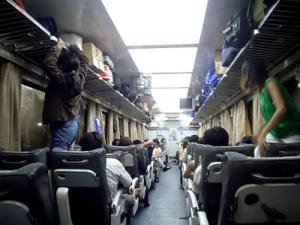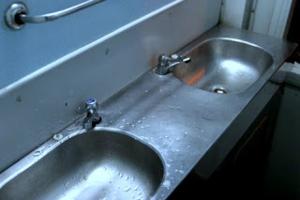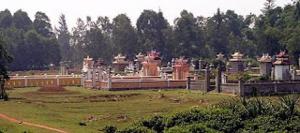Though not the fastest, nor at times the most comfortable method of travel, the train does provide certain joys and benefits one could not experience any other way. Before I had even set foot in Viet Nam, I knew that I wanted to experience the Ha Noi/Sai Gon (or Ho Chi Minh city, if you will) at least one way. I did have some preconceived notions about train travel,-one of them being that it is subliminally romantic. Train travel allows you immersion which is simply unaffordable at 41,000 feet in the air; you can breathe the air and live the day of a Vietnamese in small ways: you will follow their footprint in the manner in which they get from point A to point B. You will purchase a ticket, and even though you may not be in the same class, the cars will succeed one another on the same track, and you will arrive at destination with more or less the same story to tell.

The trains are not without drawbacks, and if you are the type of traveler that must go first class, and chooses the 5 star or 6 star hotel, then this is not for you. Though you might enjoy the luxury car, which we did spot from the outside of the train; it was a dead giveaway, with its white lacy curtains, the victorian lamp that appeared at each window, and I imagine the berths must have been super cushy. Had we done that, I feel we would have missed the point.

Let me start with some of the advantages, other than cultural: it’s ridiculously cheap, and we had first class, lower soft berth tickets which is considered the best you can get without hitting the “Trump” car. Keep in mind that you may have to share your cabin with other travelers, since it’s 4 berths to a compartment. Try not to take the upper berths unless you enjoy the gymnastics of monkeying up and down every time you need to stretch. (it’s cheaper, too).It’s also quite safe. In general, the entire country is quite safe and even if I were alone, I wouldn’t hesitate to board a train. If it’s going to be a relatively short journey (say, 3-4 hours’ time), then you don’t need the berth, and might want to reserve in the seats only area. Hereagain, they have hard seats and cushy seats.

This particular train ride was Ha Noi/Sapa/Ha Noi, which is a much shorter journey than the one we had taken the previous year which covered Ha Noi/Saigon and a few stops in between. Had we gone without stopping, it would have been about 32 hours. These are not high speed locomotives as you may have guessed. Most trains for Sa Pa leave around 10PM at night, and it makes quite a bit of sense. The trek is long enough to get you into Lao Cai Station by 6:00am the next day. They do have one train that runs during daylight, but since we had photographed the entire length of Viet Nam on the prior trip, it was not crucial to travel by day.

The biggest advantage? Someone else is driving. That means that you and your companion can pay attention to each other, and look at maps, edit pictures, take more pictures, walk through all the cars to check out the local scene, have some hot coffee in the dining car (most trains have those) and make friends with other tourists in the corridors. The train does stop at other towns; you have a quick opportunity to get off and buy some snacks,-and in this case, I recommend the sesame rice cakes which are awesome and the peanuts. Of course, I come equipped as well with fruit (bananas, oranges, chocolate bars, diet coke – which is very difficult to find -) and other goodies I might find at the train station kiosks. Keep in mind that the Vietnamese know how to make wicked croissants.

The berths for me were magnificent; comfortable, with a night light overhead for reading, a little netted pouch on the side could hold my glasses. Blankets and pillows are arranged army style, and you make your own bed when you arrive. A folding table comes in very handy in the center under the window, and that’s why you need to take the lower berths. Under your berths, you can store your luggage, but keep in mind that the people above your head also have theirs. Usually, one side is reserved for the couple above, and vice versa.
Now, for the not so good news. There is one essential item you must bring on any train journey, and that would be your own toilet paper. Don’t ask why, or how the citizens here do it, because I couldn’t tell you. Just bring it. Actually, the train ride up to Sapa from Hanoi had a mountain of tissues piled in one corner of the corridor by the door, next to the lavatories. This was an unusual occurrence, and please do not count on this to happen to you. Be prepared, or very sorry. Also bring the toothpaste and toothbrush that Vietnamese hotels are so kind in providing for you on a daily basis. They did have tiny cakes of pink soap in most washing areas, but hereagain, bet on the side of safety and bring your own. The toilets are separated from the double aluminum sinks, and you want to ensure you are booked in car with a Western style toilet unless you have become adept at squatting. I feel obligated to show you the hardware below.
This is rather primitive but might be easier to negotiate for a man than for a woman. In fact, when I first arrived at Narita Airport in Japan, the first thing I did was run to the women’s bathroom, and found myself forced to squat. But at least, it was porcelain, and a very pretty beige, at that.

This could be a wonderful opportunity to bring these sanitizers which kill everything in sight. There are no paper towels for drying, so hereagain, please prepare. Another very slight drawback is the noise. But I found that it was the rumbling of the train that put me to sleep. Since this part of the train also has air conditioning, they do not look kindly upon anyone opening windows. (in case you have a crazed photographer who doesn’t wish to shoot through dirty windows…..).

What you will have missed by taking the night train is truly a sequence of breathtaking scenery. If rice is life, then Viet Nam is the bowl. Rice fields are infinite and so varied in color, depending upon the stage of the growth. Even the greens offer contrasts, and against a blue sky, or some rugged mountains, you just gape at the scene below, hoping you can slow the train just a bit more.

You also realize fairly quickly how the average Vietnamese is part and parcel of an agrarian society. They are hard at work tilling the land, with oxen, their bare hands, and sometimes missing limbs. (reminders of the American War). Everyone here gets up very early in the morning: whether in the cities or the rural areas, or the countryside, Viet Nam is working all the time. Planting, harvesting, and maintaining the family plot which is a must for every family. Graveyards and cemeteries are some of the most colorful we had ever seen.

As the sun begins to rise, you know you are approaching destination. It’s a bit chillier in these parts than in Ha Noi. Sapa has been likened to the Alps, and though I have never been to the Alps, I would say that it is indeed a most exquisite town, almost picture perfect with its Fan Si Pan peak as a back drop and a lake that need borrow nothing from the Swiss.

The landscape does change dramatically, in that there are now higher elevations, and as soon as you are off the train, and out of the station, you’ll be heading further up the mountainous roads that is not for weak hearts. Allow yourself to soak in the rice terraces: they are unlike anything I have ever seen, in pictures or otherwise. Even Bali’s rice terraces didn’t make that kind of impression on me. As you leave the station gates, also prepare to be assaulted by everyone who is looking to earn some dongs today. The train station here is very similar to all the other stations in what they offer by way of food and drink. But the architecture is unmistakably French. You’ll see what I mean very soon.
Source: Vietnam-mylife.blogspot

